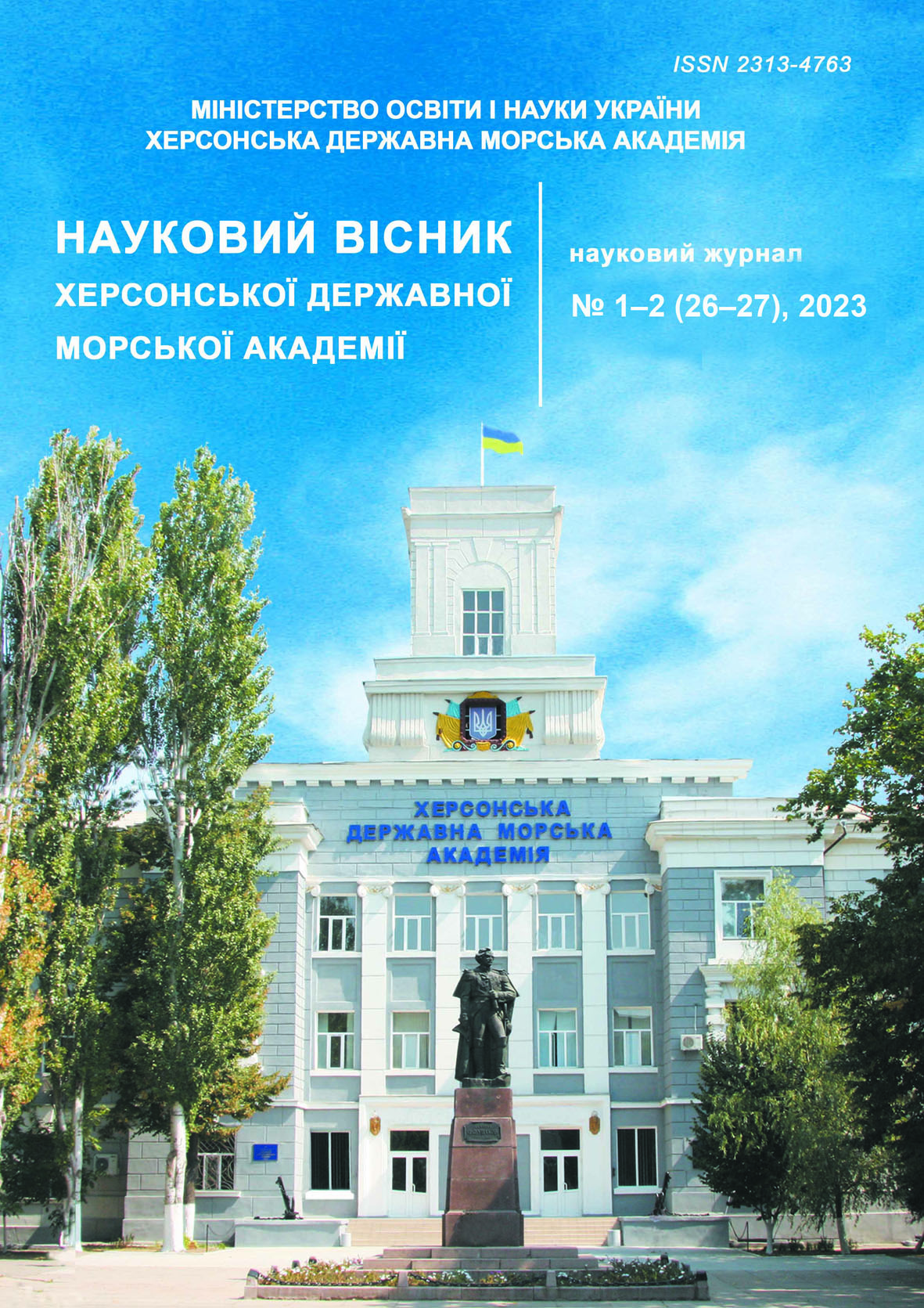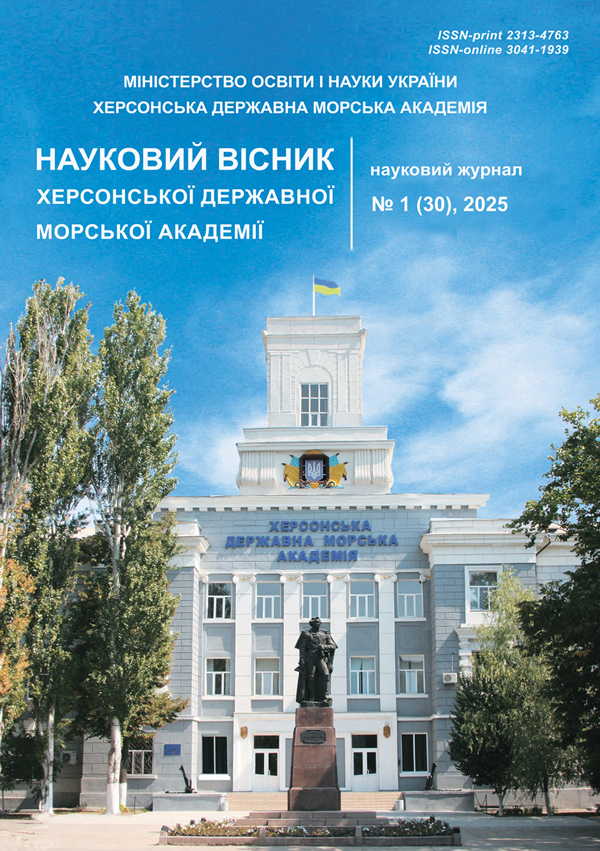BEHAVIOR MODELING AND EMERGENCY SIMULATION FOR A MARITIME AUTONOMOUS VESSEL WITH TRAJECTORY STABILITY ASSESSMENT
https://doi.org/10.33815/2313-4763.2025.1.30.195-208
Abstract
The article investigates the complex behavior of a Maritime Autonomous Surface Ship (MASS) during critical emergency situations. It specifically focuses on scenarios involving loss of control, sudden gusty winds, and steering drive failure. It is demonstrated that studying the emergency behavior of a MASS holds profound practical significance, directly addressing challenges related to the safe deployment and energy efficiency of autonomous navigational transits.
A simplified mathematical model, based on Newton-Euler equations, was employed to characterize the vessel's motion dynamics in the horizontal plane. This model accounts for hydrodynamic, aerodynamic, and stochastic effects in a simplified manner, thereby ensuring a realistic representation of the marine environment.
A critical gap identified in current MASS research is the deficit of models capable not only of reproducing the behavior of autonomous vessels during rudder blockage, loss of control signals, or unexpected disturbances, but also of predicting their cascading consequences. To address this deficiency, an innovative simulation scenario for MASS emergency modes was proposed. This scenario incorporates various navigational element failures. The simulation was conducted in MATLAB/Simulink, enabling the implementation and analysis of key emergency scenarios. This included a discrete integration step of 0.1 seconds over a 100-second simulation period, utilizing typical parameters for a small autonomous platform.
The study evaluated three distinct emergency scenarios:
– in the first scenario, the rudder was fixed at a zero position, leading to irreversible and uncontrolled course deviation due to wind gusts. This was identified as the most critical outcome, as the vessel loses its ability to perform navigational compensation, although the direction of drift remains predictable;
– the second scenario involved simulating a delay in the PID controller's command signal, mimicking an unstable connection. This revealed deviations from the desired course, indicating a partial retention of trajectory. However, it underscored that prolonged delays can induce not only aperiodic effects but also resonance, thereby necessitating adaptive control algorithms;
– in the third scenario, with the PID controller actively engaged, the system demonstrated a robust capability to quickly compensate for a strong lateral wind gust. The vessel's course stabilized within a few seconds after a minor transient overshoot, confirming a partial invariance to disturbances.
The simulation results provided invaluable insights into trajectory stability and the varying effectiveness of control strategies under adverse conditions. The presented approach to simulating critical states, achieved by fixing motion parameters during loss of control, established a fundamental database for developing proactive crisis response protocols. Furthermore, the classic PID control model was enhanced with a "freeze" function for actuators and adapted to account for changes in load and transverse speed. This enables the creation of redundant autonomous control loops, potentially through digital twin technologies. These data serve as a foundation for developing new automatic emergency response algorithms aimed at mitigating unforeseen and critical situations during future autonomous navigation missions.
References
2. Hadi, B., Khosravi, A., & Sarhadi, P. (2024). Cooperative motion planning and control of a group of autonomous underwater vehicles using twin-delayed deep deterministic policy gradient. Applied Ocean Research, 147, 103977. https://doi.org/10.1016/j.apor.2024.103977.
3. Zhang, Y., Zhao, H., Wang, J., & Wang, H. (2024). Optimal path planning for autonomous berthing of unmanned ships in complex port environments. Ocean Engineering, 303, 117641. https://doi.org/10.1016/j.oceaneng.2024.117641.
4. Deng, Y., Zhang, X., Im, N., Zhang, G., & Zhang, Q. (2020). Adaptive fuzzy tracking control for underactuated surface vessels with unmodeled dynamics and input saturation. ISA Transactions, 103, 52–62. https://doi.org/10.1016/j.isatra.2020.04.010.
5. Hassani, V., Sørensen, A. J., & Pascoal, A. M. (2012). Adaptive Wave Filtering for Dynamic Positioning of Marine Vessels using Maximum Likelihood Identification: Theory and Experiments. IFAC Proceedings Volumes, 46(33), 203–208. https://doi.org/10.3182/20130918-4-JP-3022.00041.
6. Elhaki, O., Shojaei, K., & Mehrmohammadi, P. (2022). Reinforcement learning-based saturated adaptive robust neural-network control of underactuated autonomous underwater vehicles. Expert Systems With Applications, 197, 116714. https://doi.org/10.1016/j.eswa.2022.116714.
7. Er, M. J., Ma, C., Liu, T., & Gong, H. (2023). Intelligent motion control of unmanned surface vehicles: A critical review. Ocean Engineering, 280, 114562. https://doi.org/10.1016/j.oceaneng.2023.114562.
8. Larrazabal, J. M., & Peñas, M. S. (2016). Intelligent rudder control of an unmanned surface vessel. Expert 9. Kahveci, N. E., & Ioannou, P. A. (2013). Adaptive steering control for uncertain ship dynamics and stability analysis. Automatica, 49(3), 685–697. https://doi.org/10.1016/j.automatica.2012.11.026.
10. Melnyk, O. M., Shcherbyna, O. V., Koriakin, K. S., & Burlachenko, D. A. (2021). Ohliad ta perspektyvy vykorystannia suchasnykh system kursovkazannia na morskykh sudnakh dlia zabezpechennia navihatsiinoi bezpeky [Overview and prospects of using modern course-indicating systems on sea vessels to ensure navigation safety]. Naukovi visti Dalivskoho universytetu, (21). https://doi.org/10.33216/2222-3428-2021-21.
11. Melnyk, O. M., Koriakin, K. S., & Loginov, O. V. (2022). Suputnykovi kompasy u systemi zabezpechennia bezpeky navihatsii suden [Satellite compasses in the system of ensuring ship navigation safety]. Rozvytok transportu, 1(12), 54–63. https://doi.org/10.33082/td.2022.1-12.05.
12. Melnyk, O. M., Onishchenko, O. A., Voloshyn, A. O., Vasalatii, N. V., Loginov, O. V., & Koriakin, K. S. (2022). Rozvytok dystantsiinykh tekhnolohii keruvannia sudnom yak faktor zabezpechennia bezpeky sudnoplavstva [Development of remote ship control technologies as a factor in ensuring navigation safety]. Rozvytok transportu, 3(14), 179–191. https://doi.org/10.33082/td.2022.3-14.13.
13. Melnyk, O. M., Naleva, H. V., Obniavko, T. S., & Onishchenko, O. A. (2022). Osoblyvosti matematychnykh modelei sudnovykh elektropryvodiv, pobudovanykh na osnovi bezshchitkovykh dvyhuniv postiinoho strumu [Features of mathematical models of ship electric drives based on brushless DC motors]. Sudnovi enerhetychni ustanovky, (45), 155–168. https://doi.org/10.31653/smf45.2022.
14. Melnyk, O. M., Kalinichenko, Y. V., Burlachenko, D. A., Nykhytiuk, P. V., & Kolesnyk, O. V. (2023). Zabezpechennia bezpeky sudnovodinnia shliakhom rozroblennia stratehii poperedzhennia zitknennia na bazi «modeli vidkrytoho moria» [Ensuring navigation safety by developing collision avoidance strategies based on the "open sea model"]. Vodnyi transport, 1(37), 71–79. https://doi.org/10.33298/2226-8553.2023.1.37.07.
15. Onishchenko, O. A., Melnyk, O. M., Kurdiuk, S. V., Drozdenko, O. I., Havryliuk, T. K., & Burlachenko, D. A. (2024). Zastosuvannia metodiv mashynnoho navchannia dlia optymizatsii marshrutiv i zavdan avtonomnykh nadvodnykh aparativ [Application of machine learning methods for optimizing routes and tasks of autonomous surface vehicles]. Nauka i tekhnika, 12(40), 1372–1386. https://doi.org/10.52058/2786-6025-2024-12(40)-1372-1386.
16. Kurdiuk, S., Dremlyuk, V., Melnyk, O., Onishchenko, O., Halagan, S., & Havryliuk, T. (2024). Prohramne zabezpechennia dlia nadiinoi peredachi danykh dlia morskykh bezpilotnykh plavalnykh aparativ [Software for reliable data transmission for marine unmanned aerial vehicles]. Sudnovodinnia, (36), 86–101. https://doi.org/10.31653/2306-5761.36.2024.86-101.
17. Melnyk, O., Onishchenko, O., Kurdiuk, S., Drozdenko, O., Havryliuk, T., & Burlachenko, D. (2024). Suchasni metody protydii bezpilotnym systemam: Tekhnolohii ta perspektyvy [Modern methods of countering unmanned systems: Technologies and prospects]. Sudnovodinnia, (36), 102–115. https://doi.org/10.31653/2306-5761.36.2024.102-115.
18. Burlachenko, D. A., & Melnyk, O. M. (2025). Modeliuvannia dynamiky rukhu morskoho avtonomnoho sudna z adaptyvnoiu kursovoiu stabilizatsiieiu v umovakh stokhastychnykh zburhen seredovyshcha [Modeling the dynamics of a maritime autonomous vessel with adaptive course stabilization under stochastic environmental disturbances]. Visnyk Natsionalnoho universytetu vodnoho hospodarstva ta pryrodokorystuvannia, 1(109).
19. Volkov, O., Petrychenko, O., & Vlasenko, Y. (2023). Danger of using autonomous ships. Sudnovodinnia, (34). https://navjournal-nuoma.learnmarine.com/wp-content/uploads/ 2023/05/34-2023_O.-Volkov-O.-Petrychenko-Y.-Vlasenko-Danger-of-us%D1%96ng-autonomous-ships.pdf.
20. Roh, H., Jeong, D., Park, S., & Kim, M. J. (2024). Qualitative Risk Assessment Methodology for Maritime Autonomous Surface Ships: Cognitive Model-Based Functional Analysis and Hazard Identification. Journal of Marine Science and Engineering, 13(5), 970. https://www.mdpi.com/2077-1312/13/5/970.
21. Mihailidis, A., & Nikitakos, N. (2023). Analysis of Risks Arising from the Use of Autonomous Vessels. Journal of Maritime & Transportation Science, 63(1), 63–74. https://www.researchgate.net/publication/377683241_Analysis_of_Risks_Arising_from_the_Use_of_Autonomous_Vessels.
22. Tsolakis, T., Georgakarakos, V., Theodoulidis, C., & Loukas, D. (2025). A risk assessment of an autonomous navigation system for a maritime autonomous surface ship. International Journal of Navigation and Port Research.
https://doi.org/10.1080/20464177.2025.2460268.
23. Poplavska, I., & Tkachenko, O. (2025). Collision Avoidance for Maritime Autonomous Surface Ships Based on Model Predictive Control Using Intention Data and Quaternion Ship Domain. Journal of Marine Science and Engineering, 13(1), 124. https://www.mdpi.com/2077-1312/13/1/124.
24. Wróbel, M. (2024). A human-centred review on maritime autonomous surfaces ships: impacts, responses, and future directions. Ergonomics.
https://doi.org/10.1080/01441647.2024.2325453.
25. Ryan, P., Horberry, T., & Fleming, B. (2022). Maritime autonomous surface ships: can we learn from unmanned aerial vehicle incidents using the perceptual cycle model? Ergonomics, 65(12), 1779–1798. https://doi.org/10.1080/00140139.2022.2126896.
26. Rhee, J. (2023). Attacks on Commercial Maritime Autonomous Surface Ships at Sea in. The International Journal of Marine and Coastal Law, 38(2), 266–291. https://brill.com/view/journals/apoc/8/2/article-p266_005.xml.
27. Veremchuk, V. S. (2023). Mizhnarodno-pravovi aspekty ekspluatatsii avtonomnoho morskoho sudna: postanovka pytannia [International legal aspects of autonomous marine vessel operation: Problem statement]. Pravova derzhava, (50), 280272. https://doi.org/10.18524/2411-2054.2023.50.280272.
28. Issa, M., Ali, A., Hussein, M., Abdelhady, S., & Eltawil, Y. (2022). Maritime Autonomous Surface Ships: Problems and Challenges Facing the Regulatory Process. Sustainability, 14(23), 15630. https://www.mdpi.com/2071-1050/14/23/15630.
29. Luchenko, Y. (2023). Challenges and Developments in the Public Administration of Autonomous Shipping. Lex Portus, (1), 9–12. https://lexportus.net.ua/vipusk-1-2023/luchenko_912.pdf.






